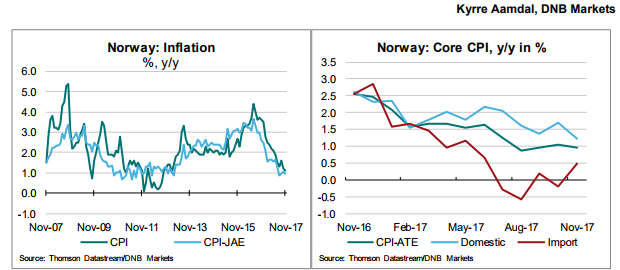Norway’s core inflation in November fell only 0.1 percentage point from October, but was clearly weaker than expected. One reason was the highly volatile air fares, but food prices have developed weaker than normal since summer.
The weakening of the NOK may contribute to lift imported inflation during the spring next year, but if NOK again appreciate and with the outlook for modest wage growth, Norges Bank will face difficulties in lifting inflation to the target over the next years. We expect therefore Norges Bank to lag the ECB and increase rates in Q3 2019.
Regarding Norges Bank’s monetary policy meeting this week, the cutoff date for the projections was probably last Friday and today’s figures will not affected the presented rate path. If so, Norges Bank will probably present a rate path indicating rate hike early 2019. But today’s figures are arguments for a lower rate path and if accounted for will make it easier for Norges Bank to present only a moderate increase in the rate path.
Domestic core inflation fell from 1.6 percent y/y in October to 1.2 percent in November, partly pulled down by falling food prices. Imported inflation rose to 0.5 percent y/y in November from -0.2 percent in October. Higher prices on clothing pulled imported inflation higher. Total inflation (CPI) was 1.1 percent y/y in November. Norges Bank projected 1.4 percent in its September report. Electricity prices rose 8.1 percent m/m and fuels rose 6 percent m/m.



 New Zealand Business Confidence Hits 30-Year High as Economic Outlook Improves
New Zealand Business Confidence Hits 30-Year High as Economic Outlook Improves  Precious Metals Rally as Silver and Platinum Outperform on Rate Cut Bets
Precious Metals Rally as Silver and Platinum Outperform on Rate Cut Bets  Gold Prices Fall Amid Rate Jitters; Copper Steady as China Stimulus Eyed
Gold Prices Fall Amid Rate Jitters; Copper Steady as China Stimulus Eyed  Singapore Growth Outlook Brightens for 2025 as Economists Flag AI and Geopolitical Risks
Singapore Growth Outlook Brightens for 2025 as Economists Flag AI and Geopolitical Risks  Gold and Silver Surge as Safe Haven Demand Rises on U.S. Economic Uncertainty
Gold and Silver Surge as Safe Haven Demand Rises on U.S. Economic Uncertainty  RBA Unlikely to Cut Interest Rates in 2026 as Inflation Pressures Persist, Says Westpac
RBA Unlikely to Cut Interest Rates in 2026 as Inflation Pressures Persist, Says Westpac  Japan Exports to U.S. Rebound in November as Tariff Impact Eases, Boosting BOJ Rate Hike Expectations
Japan Exports to U.S. Rebound in November as Tariff Impact Eases, Boosting BOJ Rate Hike Expectations  U.S. Stock Futures Edge Higher as Micron Earnings Boost AI Sentiment Ahead of CPI Data
U.S. Stock Futures Edge Higher as Micron Earnings Boost AI Sentiment Ahead of CPI Data 































